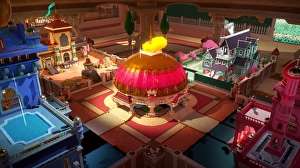
There’s an acute kind of horror to being very, very small. A lot of it’s in the timing, I think: the time it takes just to get anywhere is so long, so monotonous and lonely, that you feel oddly trapped. All that infinite expanse around you and at the same time, nowhere you can really go. Shudder. Maquette, a debut effort from San Francisco-based studio Graceful Decay, gets this – in fact it’s built on it, playing with size and space and infinite regress, and the dense atmosphere that comes with it. A game of teeny tiny footsteps and giant, clanging objects all at once, plus a touch of tilting nausea if you start to think a little too hard.
Maquette is a recursive puzzler, primarily – another stylish, concept-heavy indie from arthouse publisher Annapurna Interactive – and the core is excellent. Each level, as such, occurs under a large, domed-roof structure, several stories high. Beneath this giant dome are four gated puzzle areas arranged opposite each other, crossroads-like, and in the middle is another dome, this time only about two stories high. Beneath that middle dome is a waist-high replica of the dome you’re in: four puzzle areas, an even smaller dome in the middle. Inside that middle dome? An even more miniature replica. Back outside that first big outer dome I mentioned? An even bigger replica – and presumably on and on from there.
The puzzling comes, mostly, from the specific handful of objects that can be carried between these different replicas, and that appear in all of these worlds at once. This is also where things become very difficult to put into words, so, one attempt at an example before I just give up and quickly move on: there’s a giant red cube blocking your path in the medium-sized (normal-sized?) world, so giant it’s too big to move. However, turn towards the little replica in the middle, and the cube is also in there, to scale, and therefore only about knee-height – small enough to be picked up. So pick up the little cube and drop it somewhere else, and – tada! – now the path where the big cube was is clear too.
